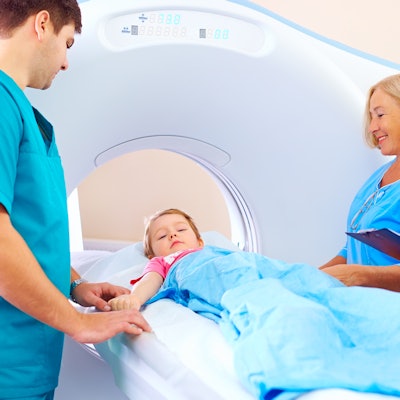
There is a strong and clear need for changes to CT protocols for children with minor head injuries, say researchers from the Netherlands who have discovered that strict adherence to the current national guidelines was associated with overuse of the modality. Their findings were published online on 5 February in Acta Paediatrica.
The group, led by senior author Dr. Frans Plötz, PhD, a pediatrician at Tergooi Hospital in Blaricum, set out to determine if the Dutch national minor head injury guidelines published in 2010 were associated with CT overuse in children. The guidelines required the presence of at least one of several major symptoms or criteria -- such as a seizure, vomiting, or altered behavior -- before clinicians were allowed to order a CT exam for children younger than 6 years old. For children at least 6 years old, there had to be at least one major criterion or two minor criteria.
Their investigation was motivated by recent reports that overall CT utilization rates for all individuals with a head injury increased from roughly 19% to 34% after implementation of the guidelines, according to Plötz and colleagues. This increase was most notable in adults and in children at least 6 years old; both of these age categories have the same criteria for CT scanning.
For their retrospective study, the researchers acquired CT data from 1,002 children who presented to one of six hospital emergency departments with a minor head injury between April 2015 and December 2016. Approximately 54% of the children were male, and their average age was 5.5 years. Adherence to the Dutch national guidelines was 69% for the various physician specialties involved.
Among all cases that followed the guidelines, 44% of the children underwent a head CT exam, the team found. However, only 13% of these CT exams displayed abnormal findings indicating a possible need for continued treatment. Further evaluation revealed that roughly half of these abnormalities were irrelevant, and none of the children required a surgical intervention.
| Pediatric head CT scanning following Dutch national guidelines | |||
| 2 years old or younger | 2 to 5 years old | 6 years old or older | |
| CT utilization rate | 18.7% | 48.1% | 62.8% |
| Proportion of CT scans revealing abnormal findings | 20.9% | 13% | 10.8% |
The low percentage of CT scans showing an abnormality affirms that the vast majority of the CT exams ordered may not have been necessary -- suggesting that new guidelines are needed to safely reduce CT scan rates in children with a minor head injury, the authors noted.
Using the data, the researchers identified four criteria that predicted clinically significant abnormalities on the CT scans:
- Suspicion of a fracture at the skull base (odds ratio [OR] of 118.3)
- Glasgow coma scale score of less than 15 (OR, 6.3)
- Scalp hematoma or external skull lesion (OR, 3.4)
- Vomiting (OR, 2.4)
"The best way to [evaluate potential new guidelines] is to compare the different validated clinical decision rules for our cohort with a comparison analysis that examines sensitivity, specificity, and CT rates," they wrote. "This will provide a reasonable indication about which guidelines may be most suitable for the Dutch population."



















